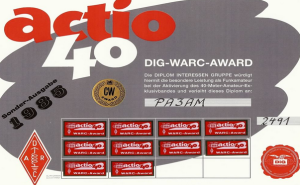40M is my favourite band the last few years as it is like a HF band that works at night time but allows you to work any distance, if properly equipped. The widely differing propagation conditions on 7MHz during a 24hrs period, and the differences between summer and winter conditions, make this a very useful band for both local and DX-working. As CW is my favourite mode I’m QRV almost every day in the CW part from 7.000 up to 7.032MHz.
The 40-meter or 7-MHz band is considered one of the most reliable all-season DX-bands, most useful for inter-continental communication for one or two hours before sunset, during the night and for one or two hours after sunrise. It is extremely useful for short to medium distance contacts from local contacts out to a range of 500–1500 km or more, depending on conditions, during the day. In higher latitudes, daytime intercontinental communication is also possible during the short days of winter, for example a good path often opens between Japan and northern Europe in the hours leading up to European midday from late November through late January, with a long path opening to the west coast of the USA and canada after midday.
For many years the portion of the band from 7100–7300 kilohertz has been allocated to short wave broadcasters and not available to radio amateurs. At the World radio Conference WRC-03 in 2003 it was agreed that the broadcast stations would move out of the section 7100–7200 kilohertz on 29 March 2009 and that portion would become a worldwide exclusive amateur allocation afterwards. Discussions on releasing the remaining 100 kHz of the band to amateurs at a later date will continue in future conferences. Many European countries allow amateur communication in the 7100–7200 kilohertz section on a shared non-interference basis as an interim measure.
Due to the 24-hour nature of the band, the wide variety of ranges that can be spanned with it, and its shared nature, it tends to be extremely crowded, and interference from other amateurs and broadcasters can be a serious limiting factor.
With its unique combination of intra- and intercontinental communications possibilities, 40 meters is considered a key band in building a winning HF contesting score during any part of the sunspot cycle.
Coz I luv forty, gotta luv it !
I’m not really a award hunter, but some awards are “Adrenalizing” and my nr. 1 Focus is getting the DIG Aktio40-award. For this award you will have to work within one month a 100 different HAM-stations on the 40 meter band. Log requirements are: Callsign, Date, Time, Mode, name and QTH. For me of course CW-only !
For every realised month a sticker is available and I’m proud to say I’ve realised all 12 months. Friday 17th of june I made a QSO wd Ray G4NBO on 40 meters 20:11 UTC, working for my Aktio40 award. this was QSO #100 for this month. This meant I could apply for a full award, as this was month #12.
I started in august 2008 and it thus took me 3 years (34 months) and resulted in 1412 QSO’s, 1161 unduped, 57 DXCC all on 40 meters. A great experience in CW!

Checking conditions on 40 meters can be done by listening to the Russian single letter (QRP) beacons, around 7.039 to 7.040 MHz. They only key at abt 12 wpm a single letter repeated ant continuous intervals. No data know on power levels, but some do mention these stations as QRP-beacons. Just try to hear these ‘famous’ beacons from the old USSR.
Here is what I have received or found (info) until now, over the years:
A – Astrakhan? 7039.1 MHz
C – Moscow, European Russia 37.58E 11.72N 7.039,0 MHz
D – Odessa, Ukraine 30.70E 46.48N 7.038,7 MHz
F – Vladivostok, Asiatic Russia 131.85E 43.14N
K – Khabarovsk, Asiatic Russia 135.10E 48.50N 7.039,3 MHz
L – St Petersburg, Eur. Russia
M – Magadan, Asiatic Russia (near Korea) 7.039,3 MHz
O – Moscow, European Russia 37.58E 11.72N
P – Kaliningrad, Eur. Russia 20.50E 54.72N
R – Ustinov,
S – Archangel European russia 41.00E 64.66N 7038,9 MHz
U – Murmansk, Eur. Russia 33.08E 68.97N
X – Prague, Czech Republic 14.43E 50.08N
yu – Kholmsk, Asiatic Russia * yu is dididahdah *
V – Tashkent 7.002 MHz
If you can hear the “K” condx ok ! see http://www.smeter.net/propagation/beacons/7039.3-k-petropavlovsk-kamchatskiy.phpThe 7039.3 kHz “K” Cluster Beacon in Petropavlovsk Kamchatskiy operates 24/7 and provides a good indication of 40-Meter propagation conditions from north-east Asia to receiving locations throughout the world.
Nice video from OM Arend PA2AWU on: http://www.youtube.com/watch?v=Vbb71VHZciA&feature=player_embedded where PA6Z station is listening these beacons on 2-Lambda long Beverage-antenna’s for 40 meters.
Didahdidahdit